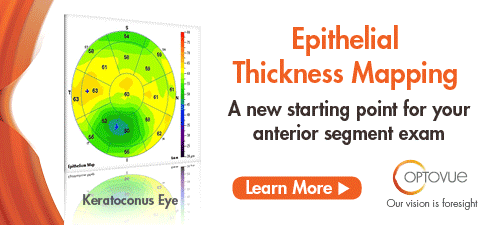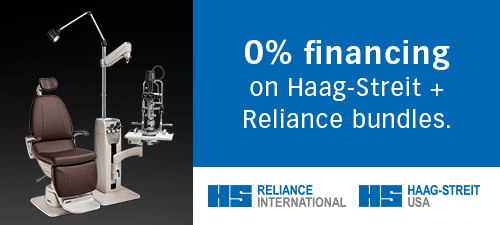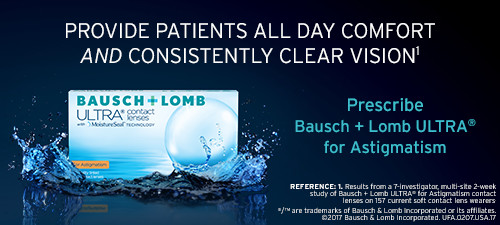
A
weekly e-journal by Art Epstein, OD, FAAO
Off the Cuff: Self-Worth
In the jungle that is eye care, opinions on who rules the roost will vary greatly. Ask the American Academy of Ophthalmology, and I imagine they still perceive a massive gap between the two professions. Ask our AOA, and they will likely remind you that optometry is the primary eye care provider in the US and a profession that continues to evolve and expand. Fair Market Value or FMV for short is how most of the health care industry determines what a health care provider’s time is worth. Sadly, when it comes to optometry, most ODs, including some of our most respected and recognizable leaders, are paid much less than their MD counterparts are—for the same services. So, when an OD sits next to an MD at an industry advisory board, the MD may actually be paid two or three times as much as his OD colleague for exactly the same work.
|
|||||
|
||||
| Risk of Developing Open-angle Glaucoma in Patients with Carotid Artery Stenosis: A Nationwide Cohort Study | ||||
Whether carotid artery stenosis (CAS) is an independent risk factor for open-angle glaucoma remains unclear. In this study, researchers investigated the association between CAS and the development of open-angle glaucoma in the Taiwanese population-based cohort derived from a longitudinal database containing claims data from the Taiwan National Health Insurance (NHI) program. The study enrolled 2,093 patients with CAS and 8,372 patients without CAS matched by age and sex from 1999 to 2010. Diagnoses of open-angle glaucoma (OAG) were identified during a follow-up period lasting through December 31, 2013. A Cox proportional hazards model was applied to evaluate the hazard ratio (HR) for OAG in the CAS cohort compared with the matched cohort. Researchers found that the HR for open-angle glaucoma in the CAS cohort was similar to that of the matched cohort. The adjusted HR for OAG in the CAS cohort was 1.50 (95% confidence interval, 1.11 to 2.02, p=.008). The Kaplan-Meier analysis revealed that the CAS cohort had a higher cumulative incidence of OAG than did the matched cohort during the follow-up period (log-rank test, p<.001). Researchers concluded that CAS was a significantly independent risk factor for the development of OAG. They added that their findings were clinically important for the aging population, which has an increasing prevalence of CAS. |
||||
SOURCE: Chou CC, Hsu MY, Lin CH, et al. Risk of developing open-angle glaucoma in patients with carotid artery stenosis: A nationwide cohort study. PLoS One. 2018;13(4):e0194533. |
||||
 |
||
| The Influence of Lens Care Systems on Eyelid Tissue Changes During Silicone Hydrogel Contact Lens Wear | ||||
This study compared the effects of a hydrogen peroxide (H2O2)-based lens care solution and a polyhexamethylene biguanide (PHMB) multipurpose solution on the eyelids when used with silicone hydrogel (SiHy) contact lenses. A total of 74 symptomatic wearers of Acuvue Oasys (senofilcon A; n=39) or PureVision (balafilcon A; n=35) contact lenses were randomized 1:1 to either Clear Care Cleaning & Disinfecting Solution or renu fresh multi-purpose solution (n=37 each). Assessments of hyperemia, papillae and lid margin staining of eyelid tissues were evaluated subjectively by a masked investigator at enrolment (with the subjects' habitual SiHy contact lenses and PHMB-preserved care systems), at dispensing visit (when no lenses were worn) and at three-month follow-up.
There were no differences in eyelid assessments between the two lens care groups at dispensing visit. After three months, the papillae response was significantly less marked with H2O2-based solution than with PHMB-based solution. Lid hyperemia and papillae were also significantly reduced. Although lid hyperemia was also reduced with PHMB-based solution, there was no concurrent decrease in papillae response. No improvements were found in eyelid margin staining either over time or between the two lens care groups. In symptomatic contact lens wearers, a H2O2-based lens care solution used with senofilcon A and balafilcon A lenses was better tolerated by eyelid tissues than was a PHMB-based solution, and led to a decrease in clinical markers of eyelid inflammation. |
||||
SOURCE: Guillon M, Maissa C, Wong S, et al. The influence of lens care systems on eyelid tissue changes during silicone hydrogel contact lens wear. Cont Lens Anterior Eye. 2018: S1367-0484(17)30331-4. |
||||

|
||
| Adenovirus Ocular Infections: Prevalence, Pathology, Pitfalls and Practical Pointers | ||||
Adenoviral conjunctivitis comprises a large number of physician office visits in the United States and places a great financial burden on health care. It is estimated that the incidence of adenovirus infection to be as high as 20 million cases per year in the United States. There are multiple adenovirus serotypes, each associated with different types and severity of infection.
Ocular manifestations of adenovirus include epidemic keratoconjunctivitis, pharyngoconjunctival fever and nonspecific conjunctivitis. Adenoviral conjunctivitis is primarily a clinical diagnosis. Laboratory diagnosis is available although until recently rarely used. At present, there is no established or approved specific effective drug against adenovirus. Treatment is primarily supportive and includes artificial tears and cool compresses. Topical antibiotics are only indicated if a bacterial coinfection is suspected or in high-risk patients such as children. As such, authors wrote that prevention against this extremely contagious disease is of utmost importance. Although most cases are self-limited and have a relatively benign course, permanent visual disability can occur. For this reason, it is imperative that all eye care providers are capable of diagnosing and effectively treating these patients, and also preventing the spread of this contagious disease to others. |
||||
SOURCE: Garcia-Zalisnak D, Rapuano C, Sheppard JD, et al. Adenovirus ocular infections: prevalence, pathology, pitfalls, and practical pointers. Eye Contact Lens. 2018; Apr 13. [Epub ahead of print]. |
||||
 |
||
| News & Notes | ||||||||
| NECO Selects Dr. Purcell As President The New England College of Optometry Board of Trustees named Howard Purcell, OD, FAAO, as the thirteenth president and CEO of the college, effective July 2. Dr. Purcell will succeed Clifford Scott, OD, MPH, who will step down after serving for nine years. Dr. Purcell began his career with 11 years in private practice in Florida with his father, NECO alumnus Saul Purcell, OD. After joining the faculty at Nova Southeastern University College of Optometry, Dr. Purcell rose to the position of deputy dean. He was later recruited by Johnson and Johnson to be senior director of professional affairs. Most recently, Dr. Purcell seved as senior vice president of customer development for Essilor of America, where he was a key member of the leadership team and executive committee for 10 years. Read more. |
||||||||
| Shone to Assist Eaglet-Eye Eyelet-Eye, manufacturer of the Eaglet Eye Surface Profiler, announced that contact lens industry veteran Tom Shone will assist Eaglet’s sales and marketing efforts, primarily in North America. Shone, who previously served as president of both Alden Optical and CooperVision, will help to market the Eye Surface Profiler topographer— designed to provide the perfect contact lens fit. Thirty contact lenses by 17 manufacturers are integrated into the ESP system, combining all lens types, from ortho-k, RGP, soft and hybrid to scleral lenses. The ESP has 2 micron accuracy for the cornea and 10 micron accuracy for the sclera. Read more. |
||||||||
| Spandow Named CFO & EVP of IDOC IDOC, a privately held alliance of independent optometrists in the United States, announced that Oliver Spandow was named CFO and executive vice president. Spandow previously oversaw the creation and launch of IDOC programs, including the new satisfaction guarantee, which gives ODs the opportunity to become a member risk-free, and the new Select Contact Lens Plan, which offers ODs enhanced choice & flexibility. In addition, the IDOC and Neil Gailmard, OD, announced that Dr. Gailmard, the group’s chief optometric officer, would sell the Gailmard Eye Center to Total ECP. Dr. Gailmard and his wife, Susan Gailmard, OD, will retire from their involvement in GEC; hwever, Dr. Gailmard will remain as IDOC’s chief optometric officer. Read more about IDOC. |
||||||||
|
||||||||
|
Optometric Physician™ (OP) newsletter is owned and published by Dr. Arthur Epstein. It is distributed by the Review Group, a Division of Jobson Medical Information LLC (JMI), 11 Campus Boulevard, Newtown Square, PA 19073. HOW TO ADVERTISE |



